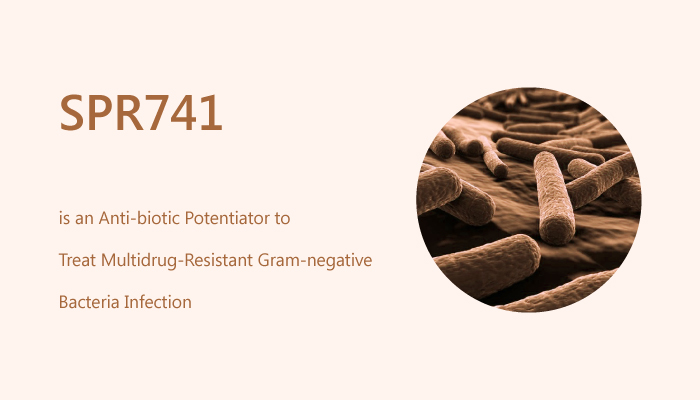SPR741, an antibiotic adjuvant that can permeabilize the Gram-negative membrane. In this article, we will briefly introduce this compound in vitro and in vivo.
SPR741 lacks significant antibacterial activity as a stand-alone agent. In contrast, it can improve the accumulation of coadministered antibiotics inside the pathogen.
Firstly, in vitro, in the presence of 8 μg/ml SPR741, Rifampin substantially reduces the MIC>8,000-fold to 0.002 μg/ml. Additional, large reductions in MICs also can be observed for the macrolide antibiotics. Erythromycin and Clarithromycin exhibits MICs to 0.03 μg/ml (1,024-fold) and 0.016 μg/ml (4,096-fold) in the presence of SPR741. Those values above are substantially below the Clinical and Laboratory Standards Institute (CLSI) breakpoint for the susceptibility of 1 μg/ml for Staphylococcus spp.
Nextly, SPR741 combines with other antibiotics that can mediate the intrinsic resistance of E. coli to certain antibiotics and overcomes the outer membrane and the AcrAB-TolC efflux system. This may link to circumvent the contribution of this pump to intrinsic antibiotic resistance.

Clarithromycin is subject to efflux by the AcrAB-TolC efflux pump in E. coli. A tolC mutant displays an increased-susceptibility to clarithromycin relative to its isogenic parent strain.
Clarithromycin and 1 μg/ml SPR741 reduce the MIC of the antibiotic against parent strain BW25113 to levels similar to those observed for the tolC and acrA mutants. Meanwhile, Fusidic acid, Mupirocin, and Retapamulin are all substrates of AcrAB-TolC. SPR741 combines with these compounds show substantial reductions in the MICs when against E. coli clinical strain ATCC 25922.
lastly, in Vivo, due to SPR741’s ability to permeabilize the outer membrane, it more sensitive to hydrophobic antibiotics.
Comparing to Polymyxin B, SPR741 has a significant safety profile. It suffers less dose-limiting nephrotoxicity in humans. Furthermore, in multiday rodent and nonhuman primate studies, Polymyxin B exhibits nephrotoxicity at a far-lower exposure-normalized dose than SPR741. However, SPR741 even shows a well-tolerated property at doses up to 1,800 mg/day in subjects.
In summary, SPR741 (NAB741) is a cationic peptide derived from polymyxin B and is a potentiator molecule. It increases the permeability of the outer membrane of Gram-negative bacteria and is used to treat severe Gram-negative bacterial infections. SPR741 can widen the spectrum of activity of the partner antibiotic when used in combination.
Reference:
Corbett D, et al. Antimicrob Agents Chemother. 2017 Jul 25;61(8). pii: e00200-17.
Eckburg PB, et al.Antimicrob Agents Chemother. 2019 Aug 23;63(9). pii: e00892-19.